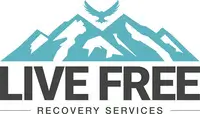Sober Living Homes in New Hampshire
Lasting recovery takes more than quitting substances—it requires support, structure, and guidance. Live Free Recovery offers a safe sober living environment in New Hampshire with personalized care and ongoing support to help you stay on track.


Halfway Houses for Sober Living
Moving from alcohol addiction treatment or drug addiction treatment back into daily life can feel overwhelming. Halfway houses, also called sober living homes, offer a safe and structured place to continue recovery. In a sober living facility, you build life skills, routines, and confidence. They offer structured support, accountability, and a sense of community.
What Is a Sober Living/Halfway House?
A sober living home is a place designed to support people in early recovery from substance use disorder. These homes provide a structured, alcohol- and drug-free environment. Residents can focus on their sobriety while getting the support they need. Unlike rehab centers, sober homes allow for more freedom while keeping house rules, meetings, and mentorship in place.
Features of Our Sober Living Program
At Live Free Recovery, we do more than provide a place to stay—we offer a full program designed to help you rebuild your life. Our sober living program includes:
Medically-assisted treatment for those who need extra support in managing withdrawal symptoms or cravings
Regular drug testing to ensure a safe and sober environment for all residents
Individual therapy sessions to help address personal challenges and build emotional resilience
Group therapy and 12-step meetings for peer support and to build connections with others in recovery
Job training and life skills development to prepare for independent living
Social activities for all residents, such as hiking, camping, and kayaking
Sober Living Homes for Men
Our men’s sober living home provides a structured and supportive environment where male residents can recover. At our halfway house, we help you form strong peer connections, focus on personal growth, and build healthy routines.
Sober Living Homes for Women
Women in recovery need a safe, nurturing space where they can heal, connect, and develop independence. Our women’s sober living home offers support tailored to the unique challenges women face in addiction recovery.
The Benefits of Sober Homes
Sober living homes provide essential support that makes long-term sobriety more achievable. Beyond having a safe and stable place to come home to, the life skills and habits formed here set you up for success. Benefits include:
- Structure and Routine – Daily schedules and house rules help create stability.
- Accountability – Regular check-ins and peer support keep residents focused on recovery.
- Safe, Sober Environment – A drug- and alcohol-free space reduces temptation and relapse risk.
- Peer Support – Living with others in recovery fosters connection and shared motivation.
- Life Skills Development – Residents learn job skills, budgeting, and healthy habits for independent living.
- Access to Resources – Therapy, 12-step meetings, and professional guidance provide well-rounded support.
What to Bring When Moving Into Sober Living
If you’ve never stayed in a group home before, it can feel overwhelming thinking about what to expect. What the living space looks like, what you need to bring, and how it all works are all great things to consider before your arrival. Being prepared for your stay makes this transition smoother. Here’s what you’ll need:
- Clothing – Comfortable, weather-appropriate outfits for daily activities
- Toiletries – Soap, toothbrush, deodorant, and other hygiene essentials
- Bedding and Linens – Sheets, blankets, towels, and pillows
- Personal Items – Books, journals, or other materials that support your recovery journey
- Medications – Prescribed and over-the-counter medications, which will be stored securely by staff
- Electronics (if permitted) – Your phone, laptop, or other devices to stay connected with work or loved ones

Making Sober Living a Regular Practice
Recovery doesn’t end when rehab does—it’s a lifelong commitment to personal growth and wellness. At Live Free Recovery, our sober living homes help bridge the gap between structured treatment and independent living. We provide outpatient programs that offer continued therapy, peer support, and professional guidance. The great thing about outpatient care is that it slots into your schedule with minimal disruption to your life.
We also focus on relapse prevention services, equipping you with real-world strategies in recovery. This helps you navigate cravings, manage stress, and avoid setbacks. You build confidence in sobriety through regular group meetings, individual check-ins, and community-based activities. With the right support system in place, sober living becomes a lifestyle that leads to lasting change.
Start Living Sober at Live Free Recovery
Choosing to live sober is one of the most important decisions you’ll ever make. At Live Free Recovery, we provide a supportive, structured environment where you can heal, grow, and rebuild your life. Our addiction treatment services help you transition from rehab to independent living with confidence and stability.
If you or a loved one is ready to take the next step, we’re here to help. Contact us today to learn more about our sober living homes in New Hampshire and start your journey toward lasting recovery.

